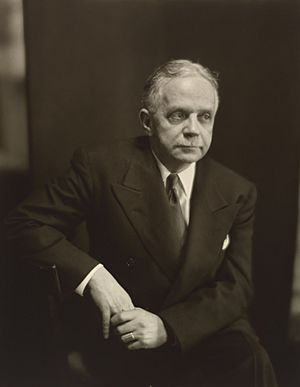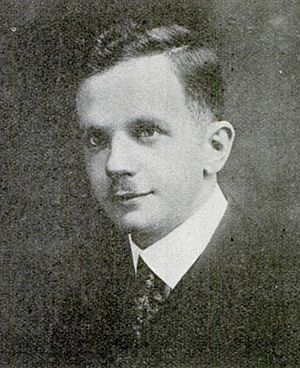Walter Francis White facts for kids
Quick facts for kids
Walter Francis White
|
|
|---|---|

c. 1950 photograph by Clara Sipprell
|
|
| Executive Secretary of the National Association for the Advancement of Colored People | |
| In office 1929–1955 |
|
| Preceded by | James Weldon Johnson |
| Succeeded by | Roy Wilkins |
| Personal details | |
| Born | July 1, 1893 Atlanta, Georgia, U.S. |
| Died | March 21, 1955 (aged 61) New York City, New York, U.S. |
| Spouses |
Gladys Powell
(m. 1922; div. 1949)Poppy Cannon
(m. 1949) |
| Children | 2, including Jane |
| Education | Atlanta University (BA) |
Walter Francis White (July 1, 1893 – March 21, 1955) was an American leader who worked for civil rights. He led the National Association for the Advancement of Colored People (NAACP) for 26 years, from 1929 to 1955. He first joined the NAACP in 1918 as an investigator.
White led many legal efforts against racial segregation, which was the unfair separation of people based on race. He also fought against disfranchisement, which meant taking away people's right to vote. Besides his work as an activist, he was also a journalist, writer, and essayist. He earned his degree from Atlanta University (now Clark Atlanta University) in 1916.
In 1918, James Weldon Johnson invited White to join the NAACP staff in New York. White became Johnson's assistant and traveled to the Southern United States. There, he investigated lynchings (when a mob kills someone, often by hanging, without a legal trial) and race riots. Because White had light skin, he could sometimes pass as white. This helped him gather information and stay safe in dangerous situations.
White became the head of the NAACP in 1929. He worked with President Truman to end segregation in the armed forces after World War II. He even helped write the plan for Executive Order 9981, which made this happen. Under White's leadership, the NAACP created its NAACP Legal Defense and Educational Fund. This fund fought many legal battles against segregation and unfair voting laws. One of their biggest wins was the Supreme Court case Brown v. Board of Education in 1954. This ruling said that separate schools for different races were not equal. White also helped the NAACP grow its membership to nearly 500,000 people.
Contents
Early Life and Identity
Walter White was the son of George and Madeline White. His father worked for the postal service, which was a respected job. His mother was a teacher. Both of his parents had graduated from Atlanta University. Walter had a good education, attending Atlanta public schools and graduating from Atlanta University in 1916.
White's family was of mixed race, with both African and European ancestors. He had light skin, blue eyes, and blond hair. In his autobiography, A Man Called White, he wrote, "I am a Negro. My skin is white, my eyes are blue, my hair is blond. The traits of my race are nowhere visible upon me." His family identified as Black and lived in Atlanta's Black community.
When Walter was eight years old, he threw a rock at a white child who used a mean word after White drank from a water fountain meant for Black people. Events like this helped shape his identity. He learned how to pass for white, which he later used to stay safe while working for civil rights in the South.
Career at the NAACP
After graduating in 1916, White worked for the Standard Life Insurance Company, a successful Black-owned business in Atlanta. He also helped start a local chapter of the National Association for the Advancement of Colored People (NAACP). He and other leaders worked to improve schools for Black children in Atlanta, who were in segregated schools that often received less money.
In 1918, James Weldon Johnson invited 25-year-old White to work at the NAACP's main office in New York City. White became an assistant secretary. He became an important undercover agent, investigating lynchings in the South. Because of his light skin and sharp investigative skills, White was very effective in fighting against mob violence.
White often pretended to be white during his investigations. This allowed him to talk freely with white people in hostile areas and learn about civil rights violations. He sometimes even joined groups like the Ku Klux Klan to expose those involved in lynchings and other crimes.
Walter White was known as a great speaker. Roy Wilkins, who later took over from White at the NAACP, said, "White was one of the best talkers I've ever heard." Throughout his career, White spoke out against segregation and discrimination.
Family Life
White married Gladys Powell in 1922. They had two children: Jane White, who became an actress, and Walter Carl White. Their marriage ended in divorce in 1949.
Later that year, White married Poppy Cannon, a white South African woman who was a magazine editor. This marriage caused a lot of discussion and upset among some of his Black colleagues.
Marie Harrison
Marie Harrison was Walter White's grandmother. She was born into slavery to a mother named Dilsia. According to White's family stories, Marie's father was William Henry Harrison, who later became President.
Fighting for Justice
Investigating Riots and Lynchings
White used his ability to "pass" as white to be more effective in his investigations of lynchings and race riots in the Southern United States. He could talk to white people as one of them, but he also identified with and spoke to Black people as one of them. This work was very dangerous. He investigated many lynchings and riots, risking his life in places like Florida, Georgia, and Arkansas.
In his autobiography, A Man Called White, he wrote about almost joining the Ku Klux Klan undercover. He used his access to Klan leaders to learn about their plans against human and civil rights. He then shared this information with the U.S. Department of Justice and the New York Police Department.
White investigated the Elaine Race Riot in Arkansas in 1919. This event involved Black sharecroppers who were trying to organize for better rights. White vigilantes attacked them, leading to many deaths. White published his findings in newspapers like the Chicago Daily News and The Crisis, the NAACP's magazine.
The NAACP provided legal help for the Black men who were wrongly convicted after the riot. The case went all the way to the U.S. Supreme Court. The Supreme Court overturned the convictions, saying the original trial was unfair. This ruling was very important for future trials.
The Scottsboro Trial
One of White's first major challenges as NAACP leader was the Scottsboro Trial in 1931. In this case, nine Black teenagers were arrested in Alabama after a fight on a train. They were accused of a crime they did not commit.
The NAACP and the American Communist Party both wanted to help the "Scottsboro boys." White believed the NAACP needed to stay separate from the Communist Party. He thought that if Black people were seen as connected to communism, it would make their fight for civil rights harder. The NAACP continued to be involved in the case, which showed the ongoing fight for justice.
White wrote about the injustice of the Scottsboro case, saying that such tragedies showed how unfair the system was and how important it was for a democratic government to address these problems.
Fighting for Anti-Lynching Laws
Walter White strongly supported federal laws against lynching. These laws were meant to make lynching a federal crime, but they faced strong opposition from Southern politicians in the Senate. White's investigations showed that most lynching victims were Black. He believed that lynching was caused by prejudice and economic competition, not just false accusations.
In 1922, the Dyer Anti-Lynching Bill passed easily in the House of Representatives. This was the first bill since the Reconstruction era that specifically aimed to protect Black people from lynchings. However, the Senate, controlled by Southern politicians, blocked the bill.
White continued to push for other civil rights laws, but they were also defeated by Southern politicians. Despite these setbacks, White and the NAACP gained a lot of public support for their cause. By 1938, polls showed that most Americans, even in the South, supported an anti-lynching law. White also helped build strong connections among civil rights activists, which was important for the movement that grew in the 1950s.
Literary Work
Walter White was involved in the "New Negro" cultural movement, also known as the Harlem Renaissance. This was a time when Black American artists and writers created many important works in Harlem, New York City.
White wrote several books. His novels include Fire in the Flint (1924) and Flight (1926). He also wrote non-fiction books like Rope and **: A Biography of Judge Lynch (1929), which studied lynching. His autobiography, A Man Called White (1948), tells his life story.
Awards and Honors
- 1927 – White received the Harmon Award for his book Rope and **: An Interview with Judge Lynch.
- 1937 – He was given the Spingarn Medal by the NAACP, which is awarded for outstanding achievements by an African American.
- 2002 – Molefi Kete Asante included Walter Francis White in his list of 100 Greatest African Americans.
- 2009 – White was added to the Georgia Writers Hall of Fame.
Death
Walter White passed away from a heart attack in New York City on March 21, 1955. He was 61 years old.
See also


